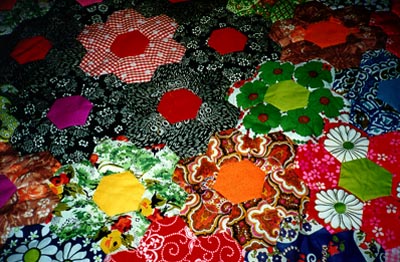Quilt No.651TRM - The Temora Rural Museum

2000 x 1450mm
This quilt was part made by Sylvia Schleibs in the Temora district NSW in the 1960s. In 1981 Sylvia's daughter, Norma Gilchrist, gave the hexagons to the Temora Rural Museum and in 1996 Marj Brown (the curator) completed the quilt by stitching the hexagons together and adding a calico border and backing.
Sylvia Schleibs was a typical farmer's wife with many interests and commitments including milking the cows and tending a large flock of chooks. She sold butter and eggs and violets, sewed, was a good cook and was practical and thrifty. She and Norma (daughter) only made hexagon quilts.
Marj Brown grew up on a farm and also married a farmer. Her interest in needlework was a great help to her in making her own and the children's clothes. She retired to Temora in 1982 where she became interested in the Rural Museum and became curator in September 1995. Her knowledge of needlework was a great help to her in repairing and finishing articles that were in storage. She likes doing tatting, crochet, knitting and embroidery of all types.
Related Quilts:
2135 x 1727mm
2185 x 1372mm
2560 x 2160mm
1630 x 1350mm
2380 x 2320mm
2400 x 1780mm.






